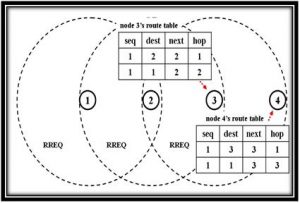OMNET AODV SIMULATION allows mobile nodes to obtain routes quickly for new destinations, and also does not require nodes to maintain routes to destinations that are also not in active communication. Ad hoc On-Demand Distance Vector (AODV) algorithm enables dynamic, self-starting, also multihop routing between participating mobile nodes wishing also to establish and maintain an ad hoc network.
Message types in AODV:
- Route request
- Route-reply
- Route error
These are all the three different message types also used by the AODV routing protocol during path selection procedure.

AODV routing table entries are:
- Destination sequence number.
- Lifetime.
- Next hop.
- Valid destination sequence number flag.
- List of precursors.
- Destination IP address.
- Network interface.
- Other state and also routing flags.
- Hop count.
Sample Output of Omnet++ AODV Routing Protocol.
Sample AODV Protocol using Omnet++ Code.
#include "AODVRouteData.h"
std::ostream & operator<<(std::ostream& out, const AODVRouteData *data)
{
out << " isActive = " << data->isActive()
<< ", hasValidDestNum = " << data->hasValidDestNum()
<< ", destNum = " << data->getDestSeqNum()
<< ", lifetime = " << data->getLifeTime();
const std::set<IPv4Address>& preList = data->getPrecursorList();
if (!preList.empty()) {
out << ", precursor list: ";
std::set<IPv4Address>::const_iterator iter = preList.begin();
out << *iter;
for (++iter; iter != preList.end(); ++iter)
out << "; " << *iter;
}
return out;
};
